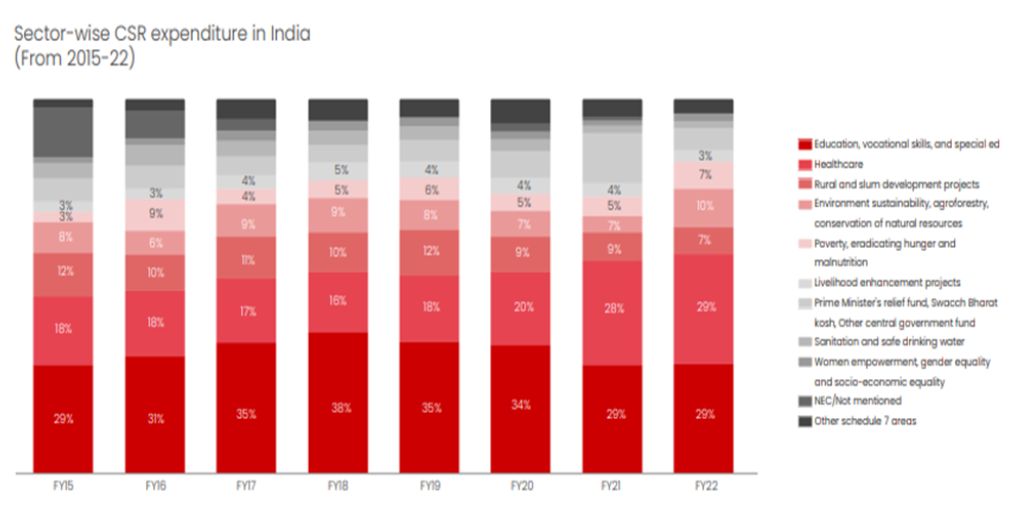Ten years ago, India’s corporate social responsibility (CSR) mandate was introduced under Section 135 of the Companies Act, 2013. The first of its kind in the world, the mandate requires companies that cross a certain size, revenue, or profit level to invest a minimum of 2 percent of their average net profits from the last three years into CSR projects.
It’s been a long, winding road since then. What was initially labelled a bold move towards funnelling private funds into the public impact space is now recognised as a reliable source of sustainable funding for long-term social initiatives.
The CSR mandate has been key to unlocking a cumulative giving capital of INR 2,17,000 crore over the last decade. And the learnings that have emerged over this period will shape the what, why, and how of corporate giving towards social impact for the next decade.
Give Grants, with research support from The Bridgespan Group, recently released a report on CSR trends. Titled Dus spoke India Inc, it offers valuable insights from 40 of India’s top 100 companies. The CSR spending of these companies exceeded INR 4,300 crore in FY 2021–22, accounting for 16 percent of the nation’s total CSR expenditure.
Here are some of the report’s key findings:
CSR of and for tomorrow
The CSR mandate has been instrumental in transforming corporate giving from ad hoc allocation of funds to strategic long-term support to projects designed with both community and stakeholder needs in mind.
The mandate elevated the importance of CSR to the forefront of decision-making, engaging board members and CxOs at the highest levels. It actively involved them in shaping CSR strategy and overseeing its implementation; this level of involvement was previously unlikely.
This shift has led to investments in the creation of dedicated CSR teams in 95 percent of the 100 corporates surveyed; 85 percent of these companies have committed CSR heads leading the charge.
Sourav Roy, CEO at Tata Steel Foundation, observes, “The mandate, to my mind, has shifted the conversation around social impact and taken it to the board level, which is not just good in the larger sense of the term but has also been empowering for teams within companies.”
In terms of financial outlay, annual CSR spending grew by approximately 3x between FY 2014–15 and FY 2023–24. During this time, corporates focused on ensuring compliance and prioritising communities that were most closely connected to their core business. In the coming decade, however, energies in boardrooms will shift towards a more powerful metric: impact. In fact, many aim to go a step further and focus on ‘catalytic impact’.
Harish Krishnan, managing director and chief policy officer at Cisco India and SAARC, states, “Some portion of CSR funds should also be viewed as risk capital and catalytic capital. It can be used to track innovative projects that have transformative potential. Successful projects can be used as proof of concept and leveraged by the government and other agencies to scale the solution for population-level impact. This experimentation is vital to catalysing new solutions and bridging gaps where conventional methods are insufficient.”
According to the report, 79 percent of the CSR leaders surveyed felt that their definitions of impact goals and outcomes require sharpening and refining. Clarity of outcomes will pave the way for their 2024–34 agenda of making CSR a powerful tool that catalyses meaningful impact. This sentiment is echoed by Sakina Baker, head of CSR at Bosch Limited and Bosch India Foundation. Sakina notes, “Discussions on how much money is spent are long gone; now the discussion is on impact.”
A significant capital of INR 7,24,000 crore is estimated to be unlocked for development over the next 10 years. As a result, annual spending will more than triple to approximately INR 1,20,000 crore by FY 2034. This number has been arrived at by analysing the earnings growth of the top 100 listed companies over the past three years as a proxy for estimating CSR allocation growth. A compounded annual growth rate of 13.48 percent was observed.

Three levers will shape catalytic CSR
The playbook for this ambitious vision is already in place, and it hinges on three levers—collaboration, investments in innovation, and investments in ecosystem and capability development.
1. Multi-stakeholder collaborations to multiply scale
Going forward, collaboration with external stakeholders will be vital to get CSR to focus on sustained positive impact.
At present, there aren’t a lot of multi-stakeholder partnerships, with only 33 percent of companies participating in such endeavours. The reasons for this vary from limited awareness of collaborative platforms to concerns about goal alignment and transparency of results.
However, there is a strong intent for greater collaboration. Approximately 87 percent of CSR leaders reported an interest in multi-stakeholder engagements with the government, philanthropic foundations, and other members of the social impact ecosystem.
“Co-creation is the coming together of partners with aligned focus. It’s about acknowledging interdependence to accomplish more as partners than as individual entities,” explains Anupam Nidhi, head of CSR at Hindustan Zinc Limited.
2. Systemic initiatives to drive innovation
A focus on programme funding with clear outcomes is the preferred approach for CSR. That by itself is not in conflict with funding innovation. In fact, 59 percent of CSR leaders are looking to transition towards supporting innovative solutions. These include:
- Funding ideas and technologies and establishing their effectiveness so that they can be scaled further by the government.
- Funding innovation via nonprofits, social start-ups, incubators, and accelerators. This will also require high flexibility in funding models (grants, work contracts, blended finance, etc.).
3. Ecosystem and capability building
There is a need for building and nurturing capacity in the sector to turn the ten-year vision into reality. This capacity building relies on the people and functions within the companies themselves as well as their nonprofit partners. Supporting capacity building is an area of interest for 33 percent of CSR leaders interviewed. Moreover, 49 percent of CSR leaders want to allocate funds towards knowledge sharing, ecosystem building, and research.
Animesh Kumar, president of HR and transformation at Zee Entertainment, notes, “We need to allow for greater flexibility and allow companies to fund capacity enhancement and capability building for the various nonprofits/implementing agencies.”
Existing barriers to impact multiplier funding
Although CSR spending is sizeable, it constitutes just 1.3 percent of government expenditure on social impact. And while the shift from funding-focused criteria to impact-oriented metrics is a step in the right direction, the path is marked with barriers. What’s interesting is that most of these barriers are not regulation-based; rather, they are rooted in perception. Some of them are listed below.
Low risk appetite: While CSR might be keen to explore innovation-based funding in the future, it still shies away from funding new concepts and bringing in new partners due to reputational and brand risk. This can be attributed to a ‘minimal risk, compliance first’ mindset, which can and should change. Calculated risk-taking in CSR should be as welcome as risk-taking in business.
Information gap: There is an information gap regarding new impact partners, whether they are nonprofits or social enterprises. There is a high barrier to discovery that can only be addressed by building and supporting platforms that house and disseminate knowledge about ecosystem partners—both new and existing—across CSR players.
Legal interpretation: Provisions of the CSR law, including Schedule VII, are expansive and leave room for liberal interpretation—a double-edged sword. The intent was to enable flexibility for corporates to do what is needed the most, and this intent has been further emphasised in the FAQs released periodically by the government. However, this flexibility has often led to conflicting points of view and myths. For example, the law does not mandate that corporates can only work with nonprofits; CSR programmes can partner with social enterprises or, for that matter, commercial enterprises—either directly or through other corporate foundations. While the law provides that administrative overheads cannot exceed 5 percent of the total CSR expenditure of a company, it does not cap nonprofit overheads. Corporates are thus free to fund capacity building if they want to.
“CSR funds are a sacred responsibility,” says Gayatri Divecha, head of sustainability and CSR at Godrej Group. “It’s not just about fulfilling regulatory requirements; it’s also about leveraging resources and reach to drive meaningful change in communities and society at large.”
Where investments ought to be
The CSR law has been valuable in unlocking dependable, long-term funding for social initiatives—a fact echoed by 87 percent of CSR leaders. However, there is still much to do.
Focus on underserved areas
Taking a more intentional approach towards equity in CSR initiatives and funding is critical, as there currently exists a funding disproportionality.
More than 70 percent of CSR expenditure has consistently been channelled towards six broad categories: education and skilling, healthcare, rural and slum development, environment, poverty eradication, and livelihoods. Gender equality, animal welfare, senior citizen welfare, agroforestry, and technology incubators remain the least-funded thematic areas. The good news is that more and more leaders are applying an equity lens to their programme design and funding decisions, with the top three focus demographics being women and girls, persons with disabilities, and Dalits, Bahujans, and Adivasis.

Moreover, to stay business-aligned, corporate investments are concentrated in regions and communities with higher economic activity. In the absence of external nudges, this is unlikely to change.

To address such issues, CSRs must chart strategies and deploy funds towards underserved areas and least-prioritised populations. A conscious effort must be taken to find the balance between business alignment and driving essential impact.
As Narayan P S, global head of sustainability and social initiatives at Wipro Limited, explains, “The whole surpasses the sum of its parts. In any sector, a comprehensive, time-spanning, and geographically diverse approach reveals leverage points and progress needs. This method needs patience. However, when observed unfolding over time, it brings a sense of fulfilment.”
Build a supportive ecosystem
An ecosystem that supports the different stakeholders can be powered by funding research on trends, challenges, and opportunities in CSR; sharing findings; and charting insights-based CSR plans.
It’s equally important to establish common platforms, forums, and gatherings to inspire dialogue among stakeholders. This will encourage partnerships, bring collaborative opportunities, and allow all to leverage collective expertise.
CSRs also need to move beyond mere funding and towards structuring a strong social sector. Flexible, multi-year grants can empower grantees to make informed investment decisions as required.
All hands on deck
It’s worth noting that at this juncture, CSR operates within the larger corporate environment. Corporate leadership teams and boards will need to encourage and support CSR’s shift towards funding innovation, which inherently has a higher risk of failure but also has the potential to scale disproportionately.
The government can always help by enabling a simplified compliance framework and fostering corporate collaboration by providing access to data. Real change, however, will be led from the front by India’s top 100 CSR leaders, and they carry the responsibility of making the next decade even more transformational than the last.
—
Know more
- Read the report that this article was based on.
- Read this article on lack of CSR investments in aspirational districts.





